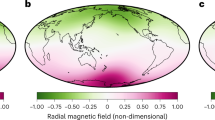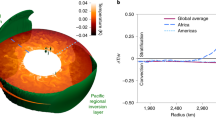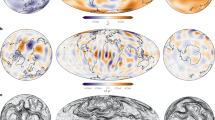Abstract
For the past few centuries, the temporal variation in Earth’s magnetic field in the Pacific region has been anomalously low. The reason for this is tied to large-scale flows in the liquid outer core near the core–mantle boundary, which are weaker under the Pacific and feature a planetary-scale gyre that is eccentric and broadly avoids this region. However, what regulates this type of flow morphology is unknown. Here we present results from a numerical model of the dynamics in Earth’s core that includes electromagnetic coupling with a non-uniform conducting layer at the base of the mantle. We show that when the conductance of this layer is higher under the Pacific than elsewhere, the larger electromagnetic drag force weakens the local core flows and deflects the flow of the planetary gyre away from the Pacific. The nature of the lowermost mantle conductance remains unclear, but stratified core fluid trapped within topographic undulations of the core–mantle boundary is a possible explanation.
This is a preview of subscription content, access via your institution
Access options
Access Nature and 54 other Nature Portfolio journals
Get Nature+, our best-value online-access subscription
$29.99 / 30 days
cancel any time
Subscribe to this journal
Receive 12 print issues and online access
$259.00 per year
only $21.58 per issue
Buy this article
- Purchase on Springer Link
- Instant access to full article PDF
Prices may be subject to local taxes which are calculated during checkout




Similar content being viewed by others
Data availability
The datasets generated as part of this study, together with the GMT scripts and data files necessary to reproduce all figures, are freely accessible on UAL Dataverse at https://doi.org/10.7939/DVN/TL8BP6 (ref. 60).
Code availability
All source codes used to generate the numerical simulations presented in this work are freely accessible on UAL Dataverse at https://doi.org/10.7939/DVN/TL8BP6 (ref. 60).
References
Jones, C. A. in Treatise on Geophysics 1st edn, Vol. 8 (ed. Schubert, G.) Ch. 5 (Elsevier, 2007).
Jackson, A. & Finlay, C. in Treatise on Geophysics 2nd edn, Vol. 5 (ed. Schubert, G.) Ch. 5 (Elsevier, 2015).
Bloxham, J. & Gubbins, D. The secular variation of the Earth’s magnetic field. Nature 317, 777–781 (1985).
Jackson, A., Jonkers, A. R. T. & Walker, M. R. Four centuries of geomagnetic secular variation from historical records. Philos. Trans. R. Soc. Lond. A 358, 957–990 (2000).
Fisk, H. W. Isopors and isoporic movements. Intern. Geodetic Geophys. Union Sect. Terrest. Magnet. Elec. Bull. Stockholm 8, 280–292 (1931).
Fleming, J. A. Physics of the Earth, Vol. VIII: Terrestrial Magnetism and and Electricity (McGraw-Hill, 1939).
Finlay, C. C., Jackson, A., Gillet, N. & Olsen, N. Core surface magnetic field evolution 2000–2010. Geophys. J. Int. 189, 761–781 (2012).
Finlay, C. C., Olsen, N., Kotsiaros, S., Gillet, N. & Tøffner-Clausen, L. Recent geomagnetic secular variation from swarm and ground observatories as estimated in the CHAOS-6 geomagnetic field model. Earth Planets Space 68, 112 (2016).
Cox, A. Analysis of present geomagnetic field for comparison with paleomagnetic results. J. Geomag. Geoelectr. 13, 101–112 (1962).
Runcorn, S. K. Polar path in geomagnetic reversals. Nature 356, 654–656 (1992).
Buffett, B. A. Constraints on magnetic energy and mantle conductivity from the forced nutations of the Earth. J. Geophys. Res. 97, 19581–19597 (1992).
Buffett, B. A., Mathews, P. M. & Herring, T. A. Modeling of nutation-precession: effects of electromagnetic coupling. J. Geophys. Res. 107, ETG 5-1 (2002).
Koot, L. & Dumberry, M. The role of the magnetic field morphology on the electromagnetic coupling for nutations. Geophys. J. Int. 195, 200–210 (2013).
Holme, R. in The Core-Mantle Boundary Region (eds Gurnis, M. et al.) 139–152 (AGU, 1998).
Schaeffer, N. & Jault, D. Electrical conductivity of the lowermost mantle explains absorption of core torsional waves at the equator. Geophys. Res. Lett. 43, 4922–4928 (2016).
Vestine, E. H. & Kahle, A. B. The small amplitude of magnetic secular change in the Pacific area. J. Geophys. Res. 71, 527–530 (1966).
Doell, R. R. & Cox, A. Pacific geomagnetic secular variation. Science 171, 248–254 (1971).
Gillet, N., Jault, D. & Finlay, C. C. Planetary gyre, time-dependent eddies, torsional waves, and equatorial jets at the Earth’s core surface. J. Geophys. Res. Solid Earth 120, 3991–4013 (2015).
Pais, M. A. & Jault, D. Quasi-geostrophic flows responsible for the secular variation of the Earth’s magnetic field. Geophys. J. Int. 173, 421–443 (2008).
Aubert, J. Flow throughout the Earth’s core inverted from geomagnetic observations and numerical dynamo models. Geophys. J. Int. 192, 537–556 (2013).
Aubert, J. Earth’s core internal dynamics 1840–2010 imaged by inverse geodynamo modelling. Geophys. J. Int. 197, 1321–1334 (2014).
Aubert, J. Recent geomagnetic variations and the force balance in Earth’s core. Geophys. J. Int. 221, 378–393 (2020).
Schaeffer, N., Jault, D., Nataf, H.-C. & Fournier, A. Turbulent geodynamo simulations: a leap towards Earth’s core. Geophys. J. Int. 211, 1–29 (2017).
Runcorn, S. K. in Encyclopedia of Physics Vol. 47 (ed. Bartels, J.) 498–533 (Springer, 1956).
Olson, P. & Christensen, U. R. The time-averaged magnetic field in numerical dynamos with non-uniform boundary heat flow. Geophys. J. Int. 151, 809–823 (2002).
Christensen, U. R. & Olson, P. Secular variation in numerical geodynamo models with lateral variations of boundary heat flow. Geophys. J. Int. 138, 39–54 (2003).
Aubert, J., Amit, H. & Hulot, G. Detecting thermal boundary control in surface flows from numerical dynamos. Phys. Earth Planet. Inter. 160, 143–156 (2007).
Aubert, J., Finlay, C. C. & Fournier, A. Bottom-up control of geomagnetic secular variation by Earth’s inner core. Nature 502, 219–223 (2013).
Labrosse, S. Thermal and compositional stratification of the inner core. C. R. Geosci. 346, 119–129 (2014).
More, C. & Dumberry, M. Convectively driven decadal zonal accelerations in Earth’s fluid core. Geophys. J. Int. 213, 434–446 (2018).
Dumberry, M. & Mound, J. E. Constraints on core-mantle electromagnetic coupling from torsional oscillation normal modes. J. Geophys. Res. 113, B03102 (2008).
Gillet, N., Jault, D., Canet, E. & Fournier, A. Fast torsional waves and strong magnetic field within the Earth’s core. Nature 465, 74–77 (2010).
Ohta, K. et al. The electrical conductivity of post-perovskite in Earth’s D″ layer. Science 320, 89–91 (2008).
Petford, N., Yuen, D., Rushmer, T., Brodholt, J. & Stackhouse, S. Shear-induced material transfer across the core-mantle boundary aided by the post-perovskite phase transition. Earth Planets Space 57, 459–464 (2005).
Kanda, R. V. S. & Stevenson, D. J. Suction mechanism for iron entrainment into the lower mantle. Geophys. Res. Lett. 33, L02310 (2006).
Otsuka, K. & Karato, S.-I. Deep penetration of molten iron into the mantle caused by a morphological instability. Nature 492, 243–247 (2012).
Dobson, D. P. & Brodholt, J. P. Subducted banded iron formations as a source of ultralow velocity zones at the core–mantle boundary. Nature 434, 371–374 (2005).
Labrosse, S., Hernlund, J. W. & Coltice, N. A crystallizing dense magma ocean at the base of the Earth’s mantle. Nature 450, 866–869 (2007).
Glane, S. & Buffett, B. A. Enhanced core–mantle coupling due to stratification at the top of the core. Front. Earth Sci. 6, 171 (2018).
Korte, M. & Constable, C. G. Continuous geomagnetic field models for the past 7 millennia II: CALS7K. Geochem. Geophys. Geosyst. 6, Q02H16 (2005).
Lawrence, K. P., Constable, C. G. & Johnson, C. L. Paleosecular variation and the average geomagnetic field at ± 20° latitude. Geochem. Geophys. Geosyst. 7, Q07007 (2006).
Holme, R. Electromagnetic core–mantle coupling III. Laterally varying mantle conductance. Phys. Earth Planet. Inter. 117, 329–344 (2000).
Buffett, B. A. & Creager, K. C. A comparison of geodetic and seismic estimate of inner-core rotation. Geophys. Res. Lett. 26, 1509–1512 (1999).
Buffett, B. A. Gravitational oscillations in the length of the day. Geophys. Res. Lett. 23, 2279–2282 (1996).
Dumberry, M. Geodynamic constraints on the steady and time-dependent inner core axial rotation. Geophys. J. Int. 170, 886–895 (2007).
Pichon, G., Aubert, J. & Fournier, A. Coupled dynamics of Earth’s geomagnetic westward drift and inner core super-rotation. Earth Planet. Sci. Lett. 437, 114–126 (2016).
Buffett, B. A. Geodynamic estimates of the viscosity of the Earth’s inner core. Nature 388, 571–573 (1997).
Cardin, P. & Olson, P. Chaotic thermal convection in a rapidly rotating spherical shell: consequences for flow in the outer core. Phys. Earth Planet. Inter. 82, 235–259 (1994).
Aubert, J., Gillet, N. & Cardin, P. Quasigeostrophic models of convection in rotating spherical shells. Geochem. Geophys. Geosyst. 4, 1052 (2003).
Gillet, N. & Jones, C. A. The quasi-geostrophic model for rapidly rotating spherical convection outside the tangent cylinder. J. Fluid Mech. 554, 343–369 (2006).
Buffett, B. A. & Christensen, U. R. Magnetic and viscous coupling at the core–mantle boundary: inferences from observations of the Earth’s nutations. Geophys. J. Int. 171, 145–152 (2007).
Jault, D. Axial invariance of rapidly varying diffusionless motions in the Earth’s core interior. Phys. Earth Planet. Inter. 166, 67–76 (2008).
Rochester, M. G. Geomagnetic westward drift and irregularities in the Earth’s rotation. Philos. Trans. R. Soc. Lond. A 252, 531–555 (1960).
Gillet, N., Jault, D. & Canet, E. Excitation of traveling torsional normal modes in an Earth’s core model. Geophys. J. Int. 210, 1503–1516 (2017).
Braginsky, S. I. Torsional magnetohydrodynamic vibrations in the Earth’s core and variations in day length. Geomag. Aeron. 10, 1–10 (1970).
Buffett, B. A. in The Core-Mantle Boundary Region (eds Gurnis, M. et al.) 153–165 (AGU, 1998).
Aurnou, J. M., Brito, D. & Olson, P. L. Mechanics of inner core super-rotation. Geophys. Res. Lett. 23, 3401–3404 (1996).
Olson, P. & Aurnou, J. A polar vortex in the Earth’s core. Nature 402, 170–173 (1999).
Wessel, P., Smith, W. H. F., Scharroo, R., Luis, J. & Wobbe, F. Generic mapping tools: improved version released. EOS Trans. AGU 94, 409–410 (2013).
Dumberry, M. & More, C. Replication data for: Weak magnetic field changes over the Pacific due to high conductance in lowermost mantle. UAL Dataverse https://doi.org/10.7939/DVN/TL8BP6 (2020).
Acknowledgements
We thank N. Schaeffer for sharing his original numerical quasi-geostrophic code, which we extended over the course of this project, and N. Gillet for sharing his flow models. Figures were created using the GMT software59. Numerical simulations were performed on computing facilities provided by WestGrid and Compute/Calcul Canada. This work was supported by a Discovery grant from NSERC/CRSNG.
Author information
Authors and Affiliations
Contributions
M.D. designed the project and wrote the manuscript. The custom numerical codes were designed and written by both M.D. and C.M. The numerical experiments were carried out and analyzed by both M.D. and C.M.
Corresponding author
Ethics declarations
Competing interests
The authors declare no competing interests.
Additional information
Peer review information Primary Handling Editors: Rebecca Neely; Melissa Plail.
Publisher’s note Springer Nature remains neutral with regard to jurisdictional claims in published maps and institutional affiliations.
Extended data
Extended Data Fig. 1 The lower magnetic field strength in the Pacific.
a, ∣Br∣ at the CMB over the time-period 1590-1990 from the gufm field model (ref. 4). The r.m.s. amplitude of ∣Br∣ in the Pacific (pink dashed circle) is 195.15 μT, the global average is 237.33 μT, for a ratio of 0.8223. b, Br at the CMB, in 2015 from the CHAOS-6 field model (ref. 8) truncated at spherical harmonic degree 16. The r.m.s. amplitude of ∣Br∣ over the Pacific (pink dashed circle) is 217.83 μT, the global average is 286.40 μT, for a ratio of 0.7606.
Extended Data Fig. 2 Equatorial planforms of the secular variation in QG model.
Snapshots of \(\frac{\partial a}{\partial t}\) (top row), \(\frac{\partial {b}_{s}}{\partial t}\) (middle row) and \(\frac{\partial {b}_{\phi }}{\partial t}\) (bottom row) from our quasi-geostrophic model for Ra = 5 × 108, Pm = 0.1 and different choices of χ. The time snapshots are the same as those for the vorticity planforms shown in Fig. 3 of the main text. The Pacific region is in the bottom section of each planform, delimited by a dashed green line in panels b, c and d. The color scales on the right are common to all 4 panels.
Supplementary information
Supplementary Information
Document containing Supplementary Information.
Source data
Source Data Fig. 4
Data points for Fig. 4.
Rights and permissions
About this article
Cite this article
Dumberry, M., More, C. Weak magnetic field changes over the Pacific due to high conductance in lowermost mantle. Nat. Geosci. 13, 516–520 (2020). https://doi.org/10.1038/s41561-020-0589-y
Received:
Accepted:
Published:
Issue Date:
DOI: https://doi.org/10.1038/s41561-020-0589-y
This article is cited by
-
Longitudinal structure of Earth’s magnetic field controlled by lower mantle heat flow
Nature Geoscience (2023)
-
Gyres, jets and waves in the Earth’s core
Nature Reviews Earth & Environment (2023)
-
Core Eigenmodes and their Impact on the Earth’s Rotation
Surveys in Geophysics (2022)
-
A Dynamical Prospective on Interannual Geomagnetic Field Changes
Surveys in Geophysics (2022)
-
Non-monotonic growth and motion of the South Atlantic Anomaly
Earth, Planets and Space (2021)



